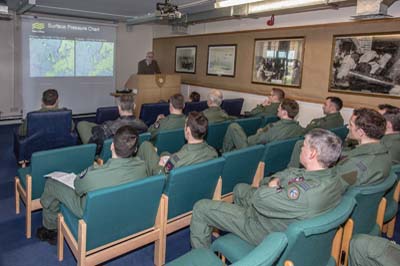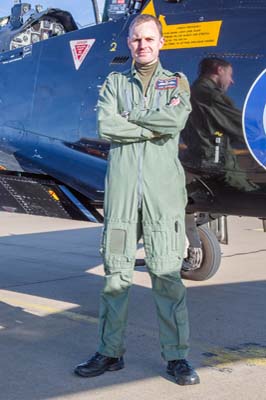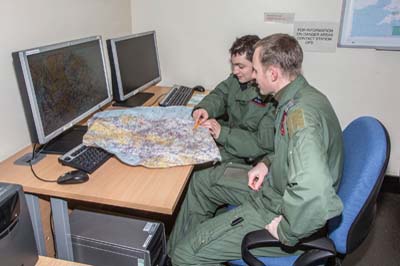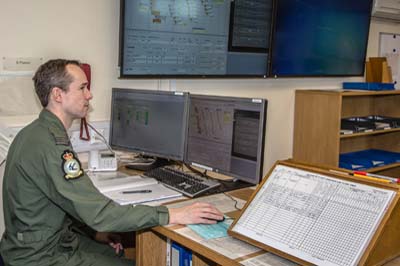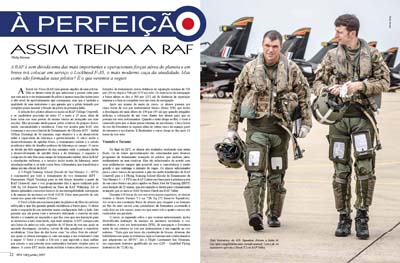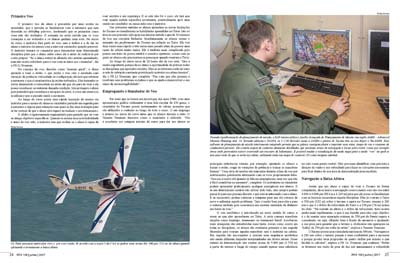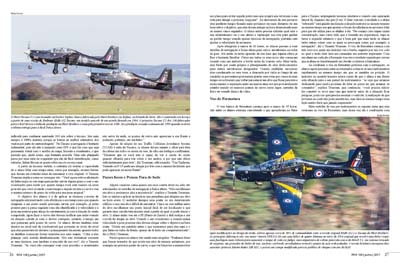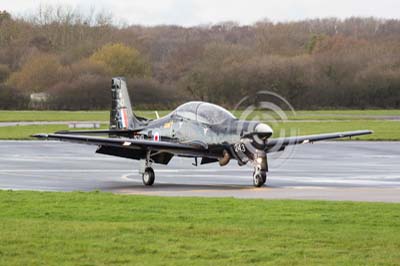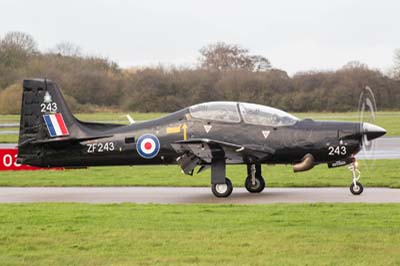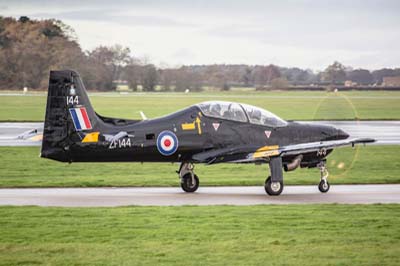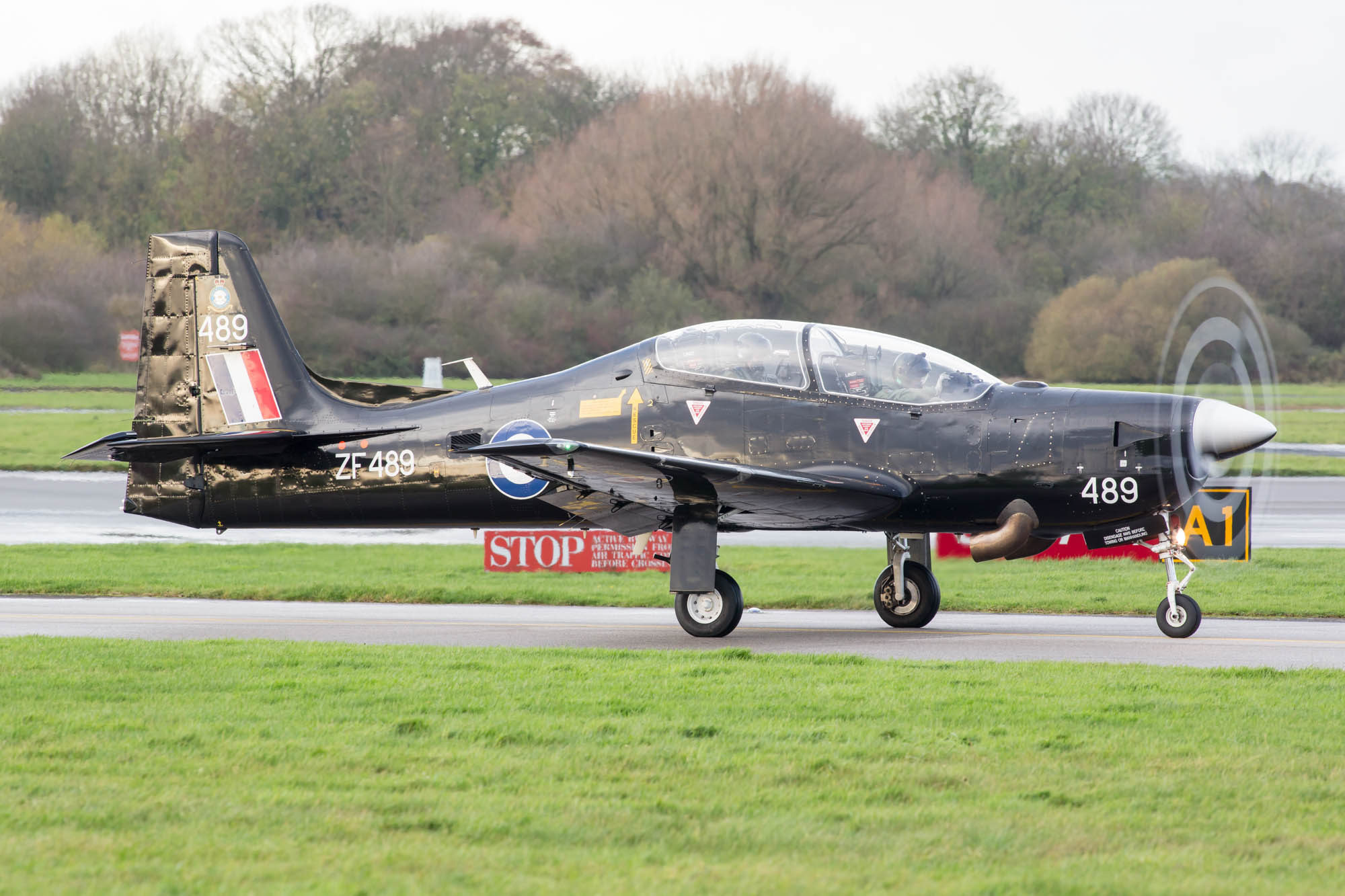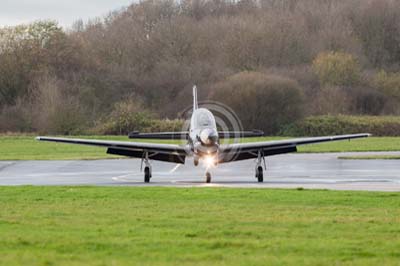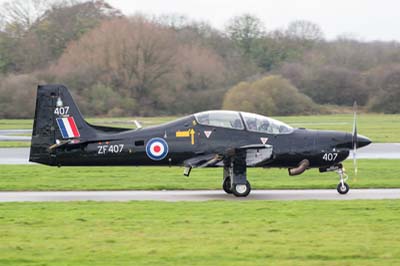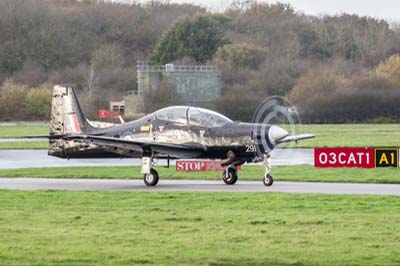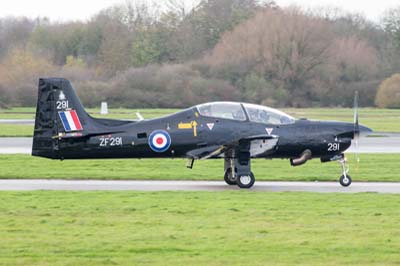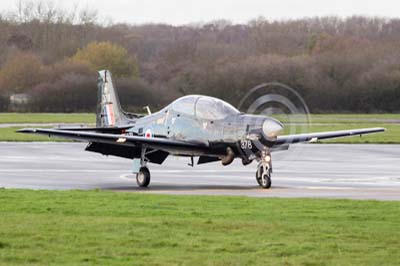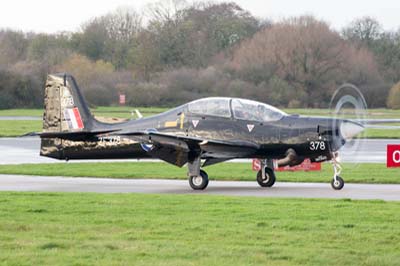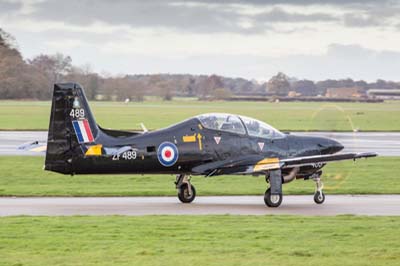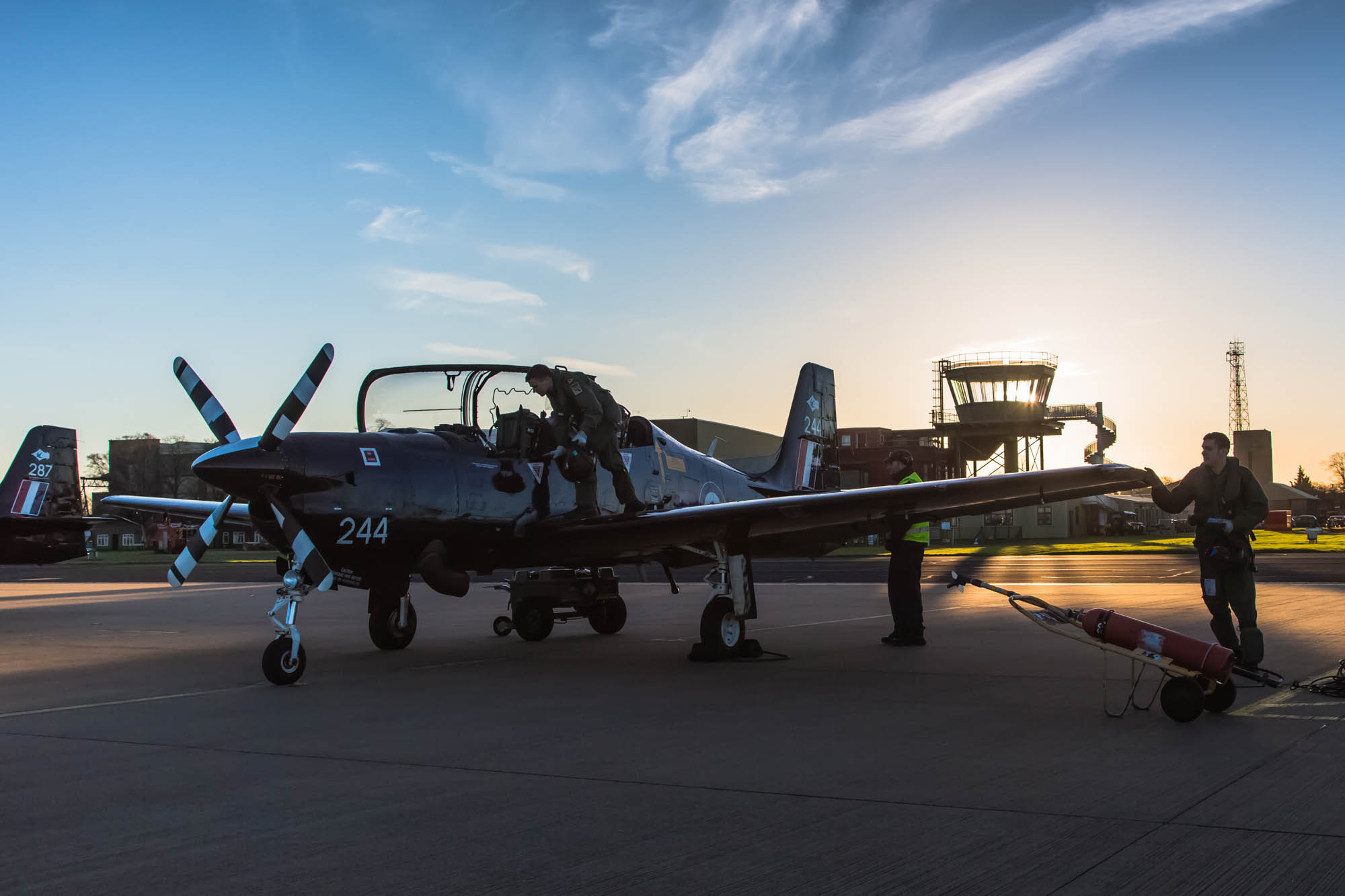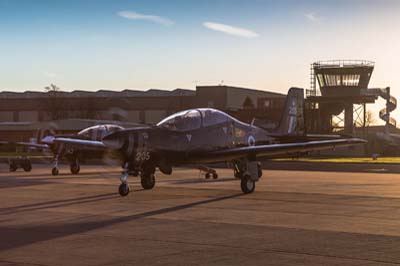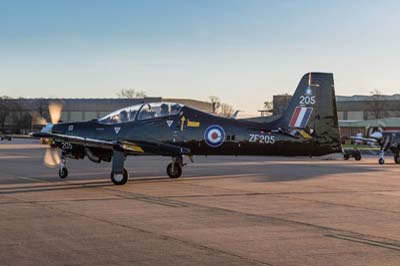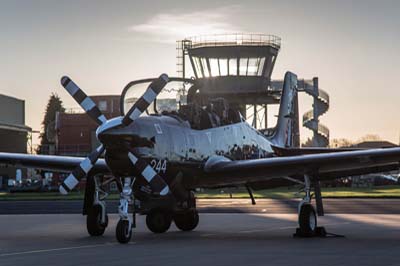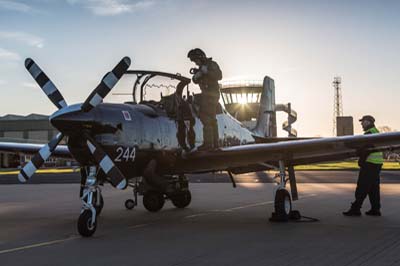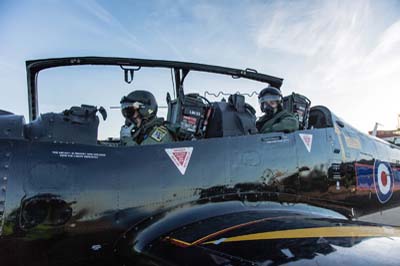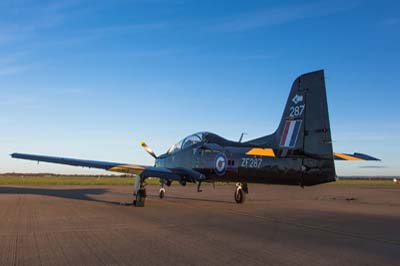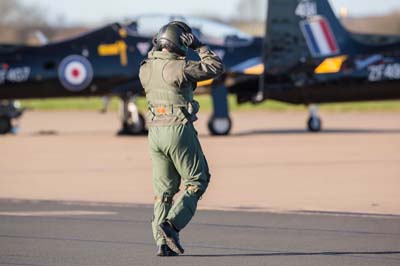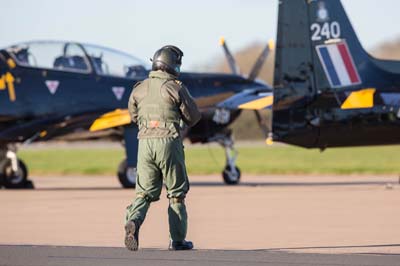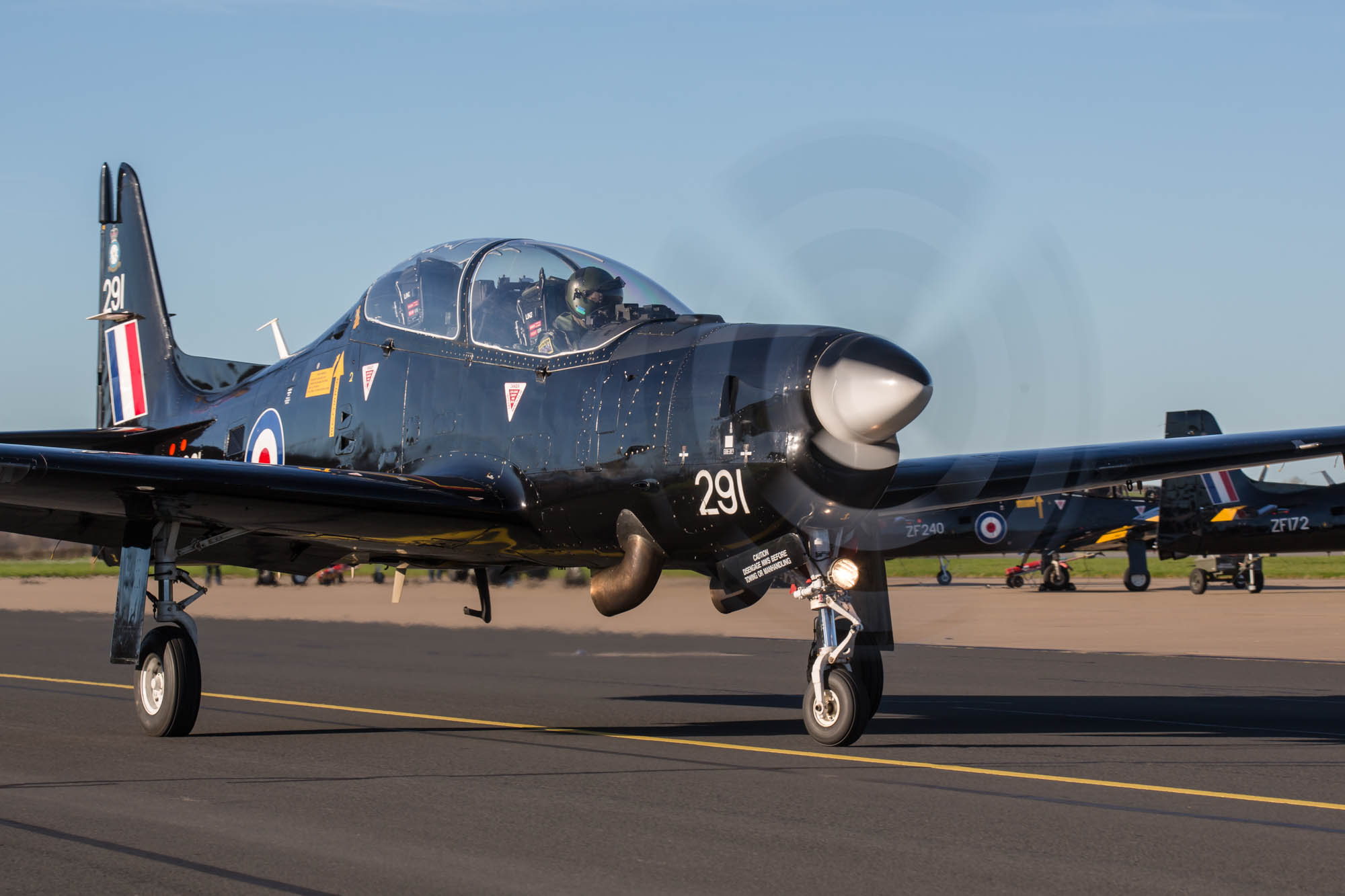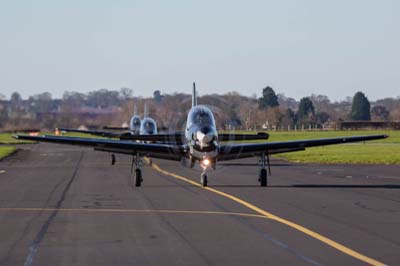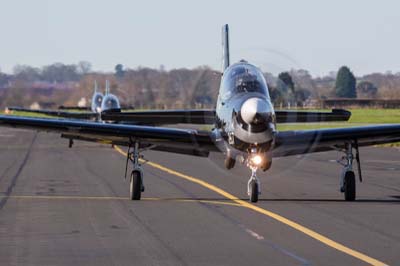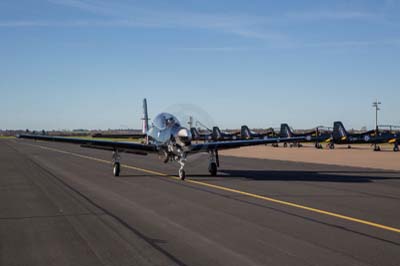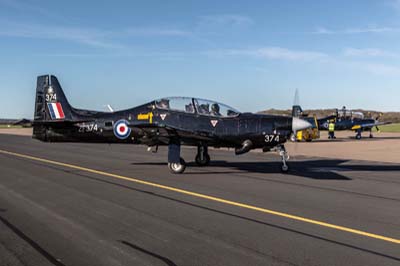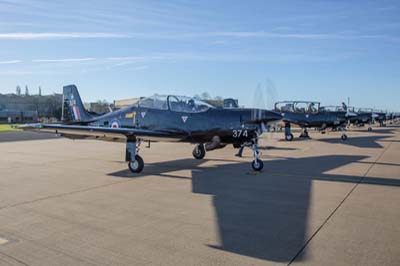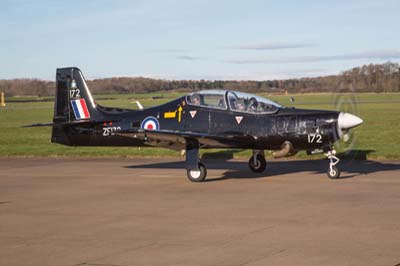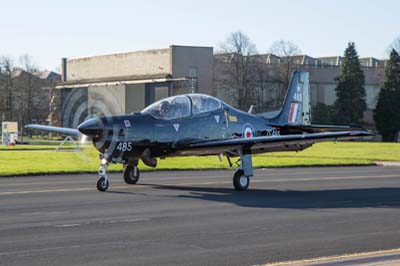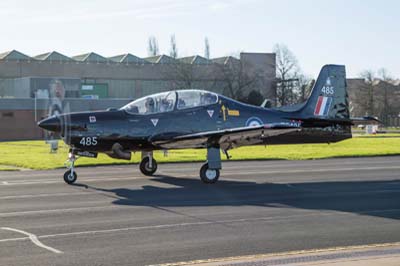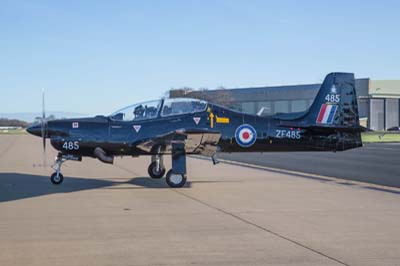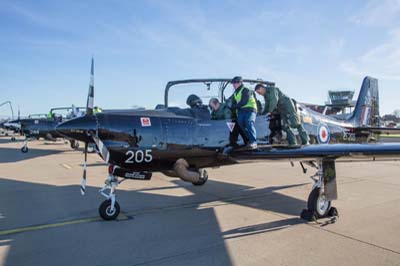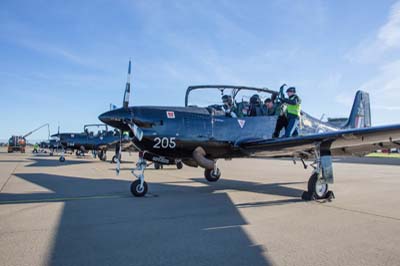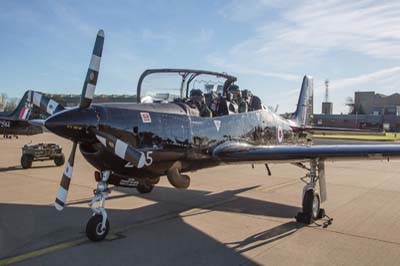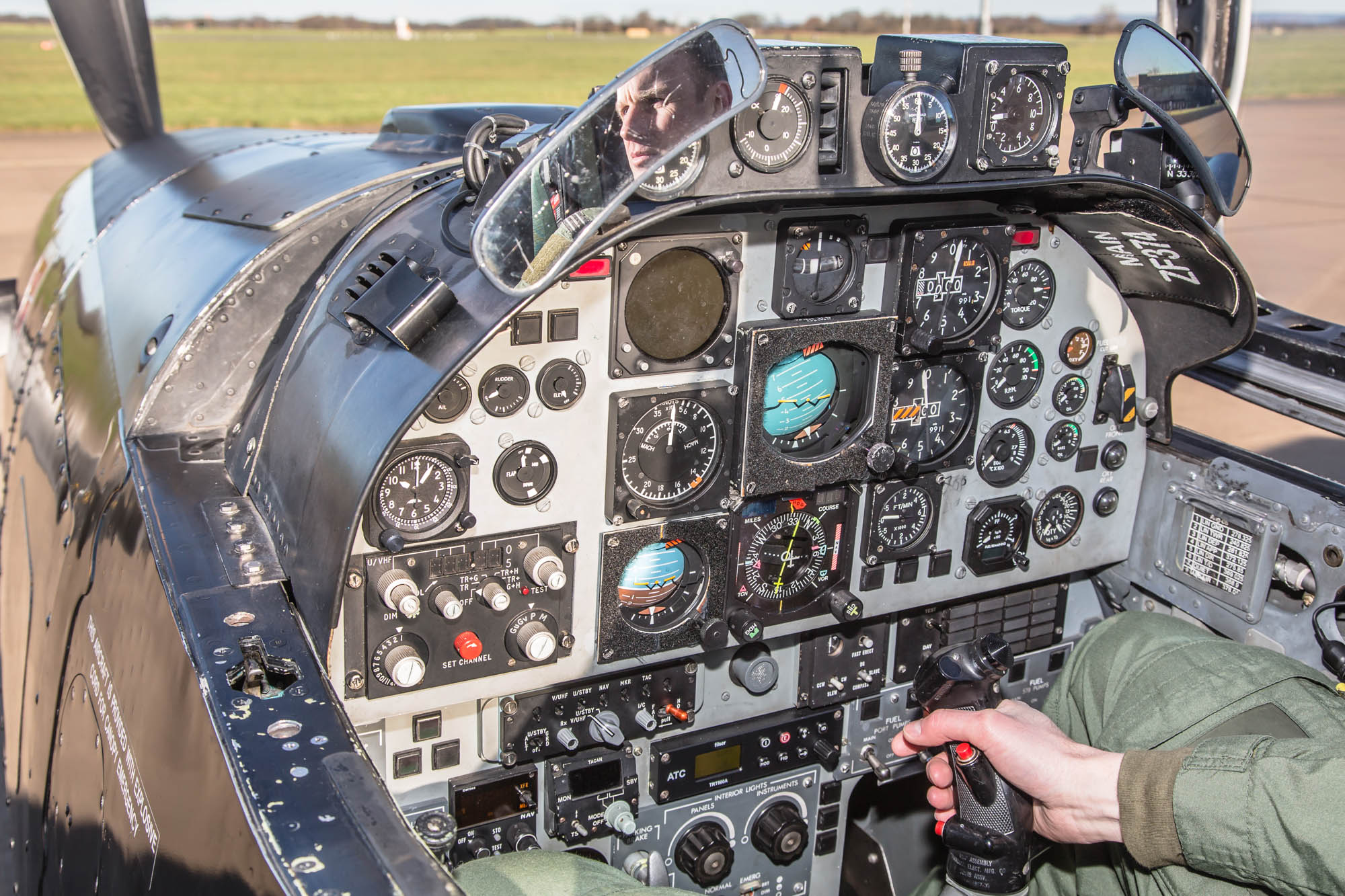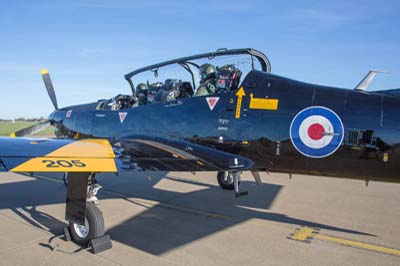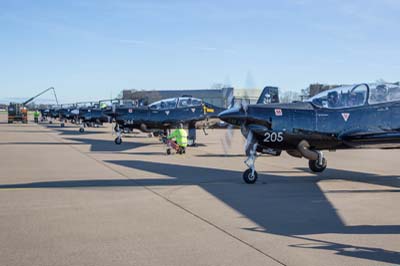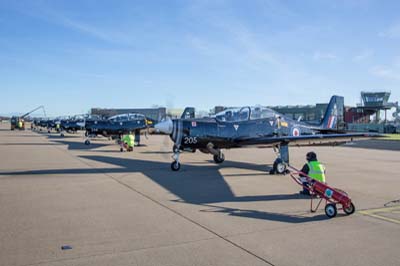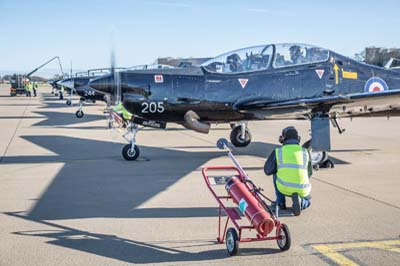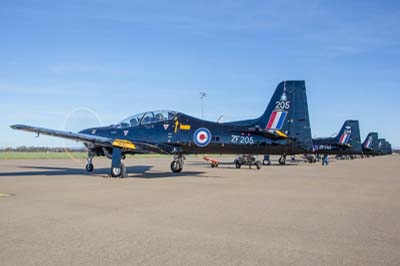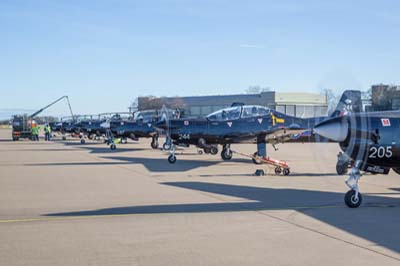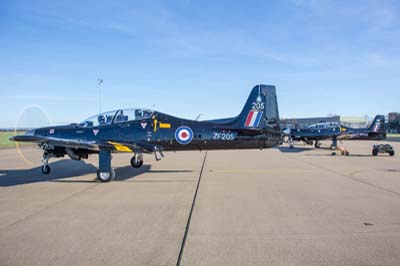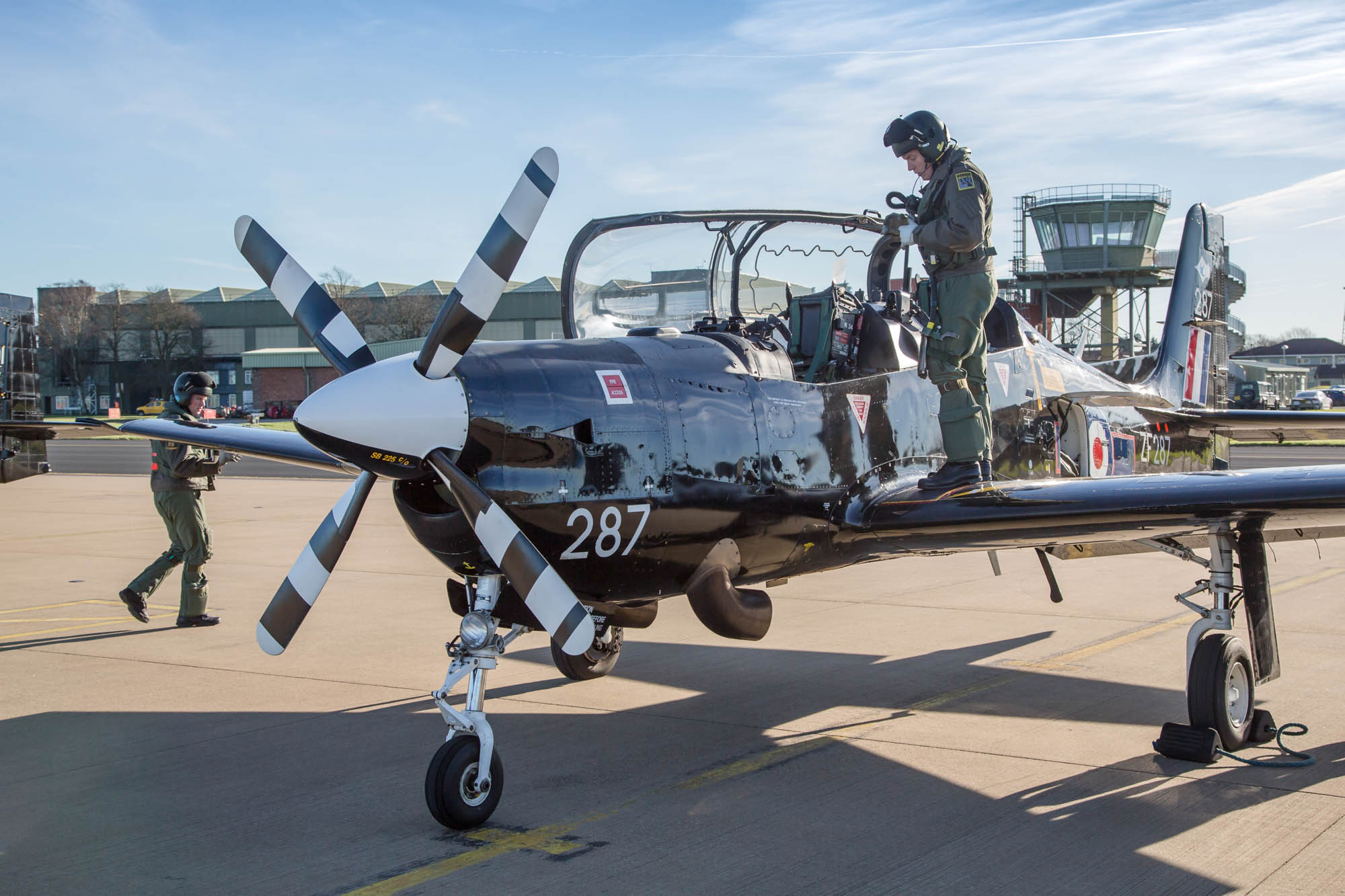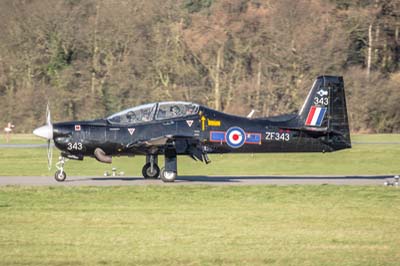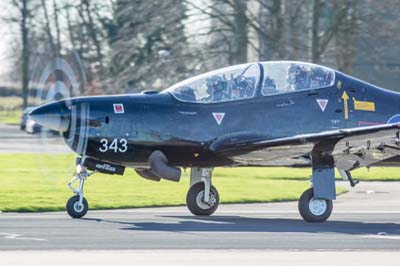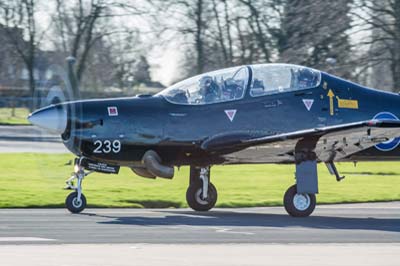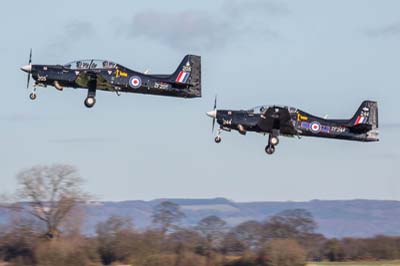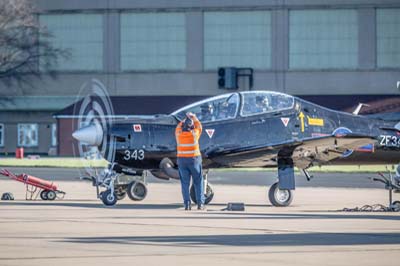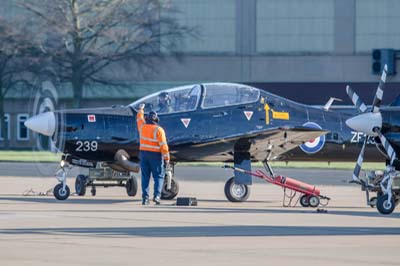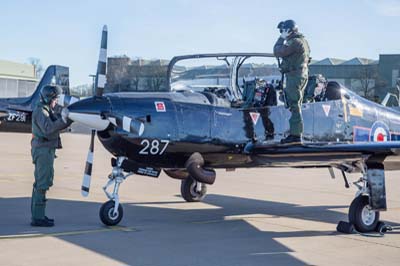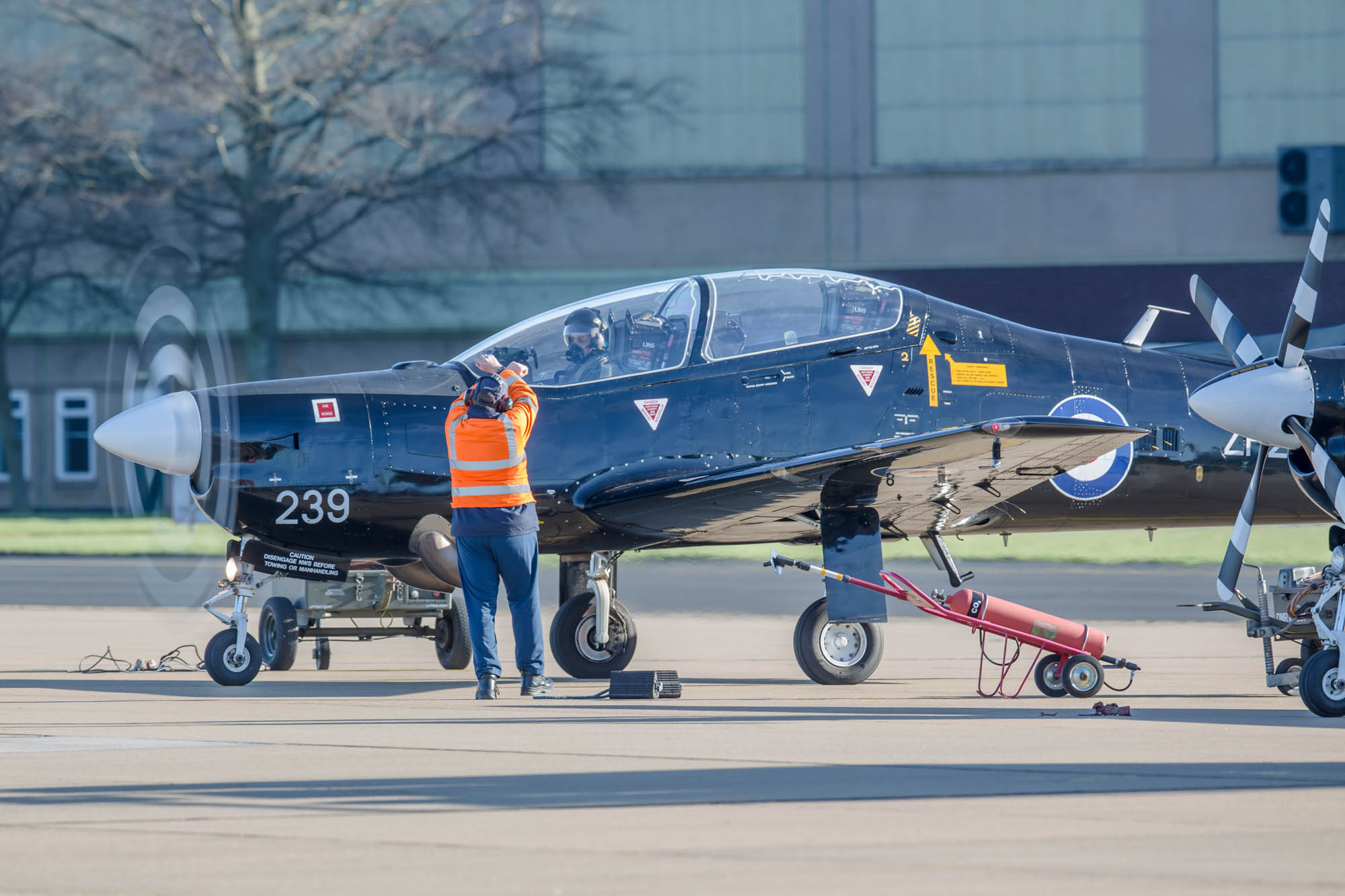The path to becoming a frontline pilot in the RAF
RAF Linton-on-Ouse, RAF Valley
October 2015 to April 2016
|
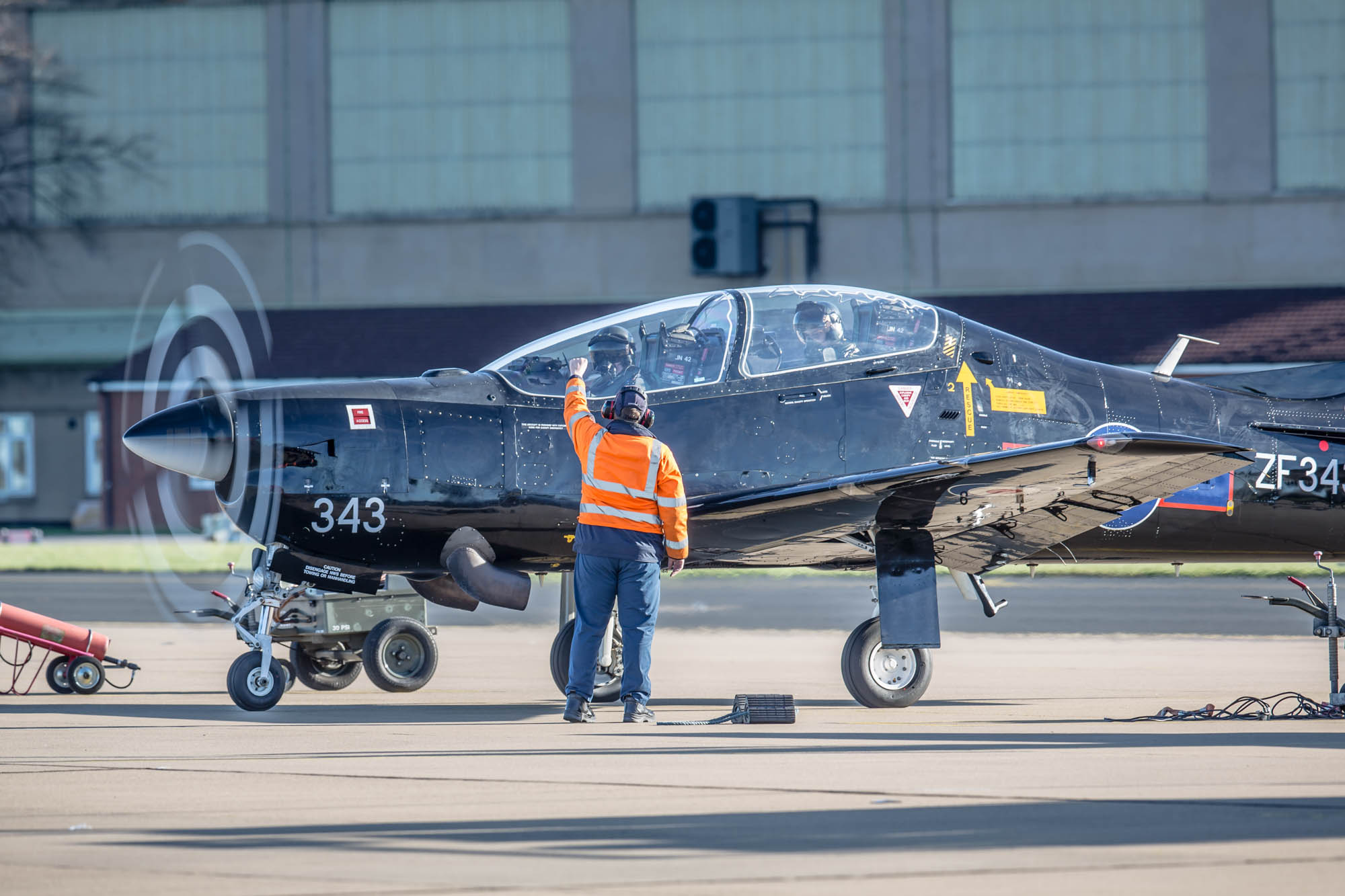 |
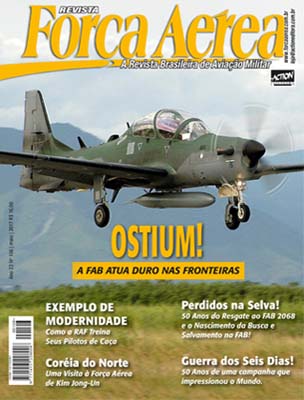 Philip Stevens for Revista Força Aérea visited RAF Linton-on-Ouse and RAF Valley to find out about the RAFs student pilot taining courses.
Philip Stevens for Revista Força Aérea visited RAF Linton-on-Ouse and RAF Valley to find out about the RAFs student pilot taining courses.
Great pilots are made not born
The Royal Air Force is proud of its pilots, they have realised that selecting the right person to begin pilot training is only one of the reasons for their high achievement and that it's also the quality of the flying instructors that ensures that the fully trained pilot is capable to take on the role of a frontline pilot.
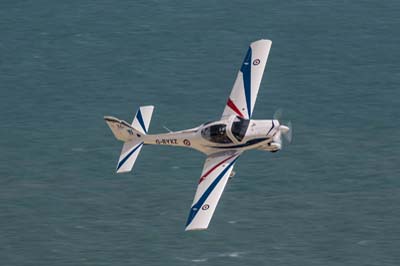 | Grob T.1 Tutors are civilian registered and as such are only cleared down to 500 feet (152m) for low-level flight training as imposed under CAA rule 5. |
Selection of student pilots begins at RAF College Cranwell, applicants must be between 17½ to 25 years old with good basic and advanced examination grades from school. They must also meet fitness, health, nationality and residency criteria. On acceptance to the RAF they start their 30 week Initial Officer Training (IOT) course which is designed to develop leadership and management skills. The course includes fitness development, military training and academic study as well as practical outdoor leadership challenges. There are three terms of ten weeks each; term one comprised fitness and leadership development, term two comprises; military training camp for seven days, RAF ethos and military simulations and term three includes; leadership academics, another military simulation and hopefully graduation and becoming an officer in the RAF.
No. 3 Flight Training School (3FTS) manages elementary flying training (EFT) for all three Armed Forces from RAF Cranwell but flying training now is carried out by 16 (Reserve) squadron at RAF Wittering. Here students are taught basic airmanship, navigation and aircraft handling skills using the Grob G115E Tutor over 62 hours of flying training in six months.
The Tutor is constructed mainly from carbon fibre reinforced plastic combining high strength with light weight. The students sits on the right side-by-side with the instructor. This allows the student to fly the aircraft with a right-hand stick and a left-hand throttle so that the transition to fast-jet aircraft is made easier.
EFT starts with six hours of ground tuition, followed by 35 hours of flying where they are given instruction on take-offs, landing, circuits, tight turns, spins and aerobatics. A ten hour 'eyes out of cockpit' phase follows with students using only a map and stopwatch to navigate. The Tutor is flown at 120 knots this equates to two miles per minute which keeps the maths very simple for students. The EFT course includes low-flying sorties with practice forced landings down to a minimum separation distance (MSD) of 100 feet (30m) dual and 500 feet (152m) solo. The low-level navigational exercises are at 500 feet (152m) MSD. This phase is completed with a navigation test.
After a mid-course test students undertake five hours of basic instrument flying, this involves taking off to a height of 150 feet (45m) when a visor is placed in front of the student so they can only see their instruments. On completing the test the visor is removed so they can recover to the airfield. There follows five hours of formation flying and another five hours of general handling and aerobatics, the course is completed with 12 hours of solo flying.
Flying the Tucano
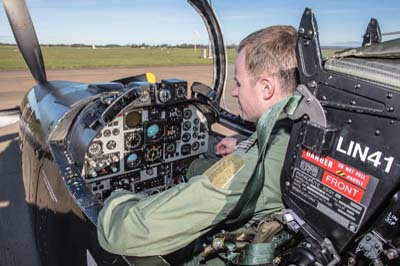 |
The cockpit of the Tucano T.1. Instructor Flt Lt Trueman at the controls described the Tucano as having the same performance as early mark Spitfires. |
At the end of the EFT course they are assessed and graded, successful students are then selected for the various advanced pilot training programmes; fast jet, multi-engine or rotary wing, they are selected according to their wishes whenever it is possible but competition for places is very high. The students selected for the basic fast-jet course transfer from RAF Cranwell to No. 1 Flying Training School at RAF Linton-on-Ouse for the first part of the 21 month basic fast-jet training (BFJT) course in preparation for their advanced training on the BAE Systems Hawk at RAF Valley.
For the next nine months and 130 flying hours they will fly the Short Tucano T.1 with 72(Reserve) Squadron. There is a continuous feed of students arriving and graduating at the end of their course with graduation ceremonies being held every two or three months for the three or four courses that run in parallel.
The course, building on what has gone before, comprises general handling including aerobatics, instrument flying, navigation, formation flying before returning to instrument flying and then on to night flying. "It's all about building blocks, a lot of the skills we train them on here are based on the skills that they learnt at EFTS", says Flight Lieutenant Jon Trueman an experienced qualified flying instructor (QFI) with 72(R) Squadron.
First Flight
The student's first flight is preceded by a session on the simulator, this is just get used to the aircraft which will be discussed in the post flight debrief, the first five sorties are not formally assessed. It's not until sortie six that the flights are assessed and the student given a grading. Early in the course the instructor will do some of the flying but the emphasis is to give the student as much hands-on teaching as possible. The instructor will take over the controls to demonstrate a discipline to show the student how it is done before they practice it themselves. "If the students are watching you they are still learning but there is no substitute for hands-on", says Flt Lt Trueman.
At the start of the flying and described as 'general handling' the student learns how to fly the aircraft, this includes flying straight and level and by changing power, speed or aircraft configuration they will then need to re-trim the aircraft which is a characteristic of a turboprop. They will practice doing stalls by slowing the aircraft down until it stops flying so they recognise the symptoms, this is to protect the student by enabling them to recognise and recover from a stall and as an academic exercise to develop their feel for the aircraft.
Throughout the course there is a rapid transition from the instructor teaching, to the student practicing on the simulator and then flying in the aircraft, to the assessment to make sure the student is safe. The syllabus is strictly regimented you fly the sortie to achieve specific objectives. When a new skill is taught and before they fly solo the instructor has to assess whether they have attained a safe solo standard, if not they will be able to re-fly that sortie perhaps after a session in the simulator or a tutorial with the instructor.
For the first few sorties they are learning the new limitations of the Tucano while transferring their skills learnt on the Tutor, leading to their first solo after their tenth sortie which is 30 minutes of flying circuits. Students are immediately aware of the step up in performance of the Tucano, it is twice as fast and three times as heavy with a higher rate of climb. It is also more complicated with retractable landing gear and ejection seats which students did not have to worry about on the Tutor.
During the course around 26 hours are flown solo, "This is very important because it gives the student the opportunity to practice all disciplines on their own and they get used to not having that constant safety net of an instructor in the back to get them out of trouble", says Flt Lt Trueman adding, "It makes them think and problem solve for themselves and develop their airmanship".
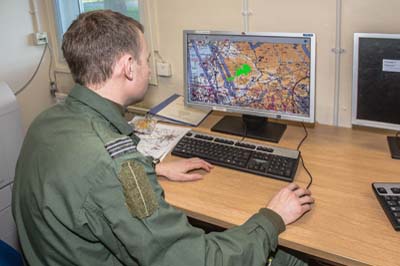 |
Mission Planning
The tailored Advanced Mission Planning Aid (AMPA) software is utilised across the RAFs fleet of aircraft, Tornados use TAMPA, C-130J Hercules use JAMPA and the Tucano pilots use TucAMPA. Using this fully integrated mission planning software pilots can plot and print their route and times and also calculate fuel consumption. The software comprises highly detailed contoured maps which show navigation warnings and 'avoids' (temporary areas to be avoided such as a hot air balloon meeting). You can switch from map to fly through mode to view the topography to show pilots what they would to see from the cockpit displayed using a 3D contoured map or satellite imagery. |
Using the flight simulator
The Tucano simulator although based on 1980s technology with rudimentary graphics and a 190 degree wrap around view has accurate cockpit features and is used throughout the course. Use of the simulator is intense at the start of the course and before they get off the ground. Flt Lt Trueman described how the simulator is utilised, "It is good in the early stages for setting the visual attitude for example, getting them used to setting the trim, power settings and practicing the basics." A number of sessions are booked during the instrument flying phase and generally alternate with actual flights. "It is useful when dealing with emergencies as there is only so much you can simulate in the aircraft", he says. The simulator instructors can give the students virtually any emergency to let them deal with it. If a scenario is not going well they can pause the simulator to discuss what is happening. If required they can reset it for the student to try again. "This is good for them and saves a lot of money with the cost flying hours" he believes.
Aerobatics are introduced on the sixth sortie in the course, building on what they learned on the Tutor starting on perhaps on their third or fourth sortie with simple manoeuvres such as a loop, aileron roll or barrel roll. More advanced aerobatics are introduced later. As with all disciplines students are first assessed and then cleared to fly those routines solo. Students will be encouraged to put together an aerobatic sequence similar to what you might see at an air show. These display routines are flown above 5,000 feet (1,524m) AGL away from the airfield using a feature on the ground as a centre point. They have to be aware of the wind direction and speed to make the corrections required to stay on their line feature.
Low-level navigation
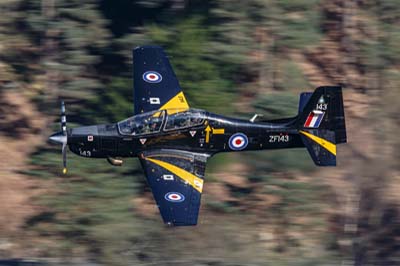 |
The Short Tucano is a two-seat turboprop basic trainer built by Short Brothers in Belfast, Northern Ireland. It is a licence-built version of the Brazilian Embraer EMB-312 Tucano which dates back to a 1984 agreement. The first Tucano T.1 of 130 for the RAF off the production line at Short Brothers flew in 1986, production continued until 1993 when the final delivery to the RAF was made. |
As soon as the student can competently fly the Tucano, cross country navigation training starts with a flight at 3,000 feet to 4,000 feet (914m to 1,219m) to get used to the techniques. They have previously flown the Tutor down to 500 feet (152m) now the Tucano is flown at 240 knots which is twice the speed of the Tutor and down to 250 feet (76m) above ground level (AGL). "At half the height and twice as fast everything happens that much quicker, which is challenging for them as they are aiming to maintain a safe and consistent Minimum Separation Distance (MSD) of 250 feet (76m) or 500 feet (152m) if flying solo, by looking well ahead of the aircraft and adjusting the flight path to ensure that terrain and obstacles do not infringe a 250 feet "bubble" round the aircraft.", says Flt Lt Trueman.
The Tucano has a top speed of 300 knots, "We navigate at 240 knots over the ground because it is more comfortable for the aircraft and equates to four miles per minute making it easy to calculate", says Flt Lt Trueman continuing "So in a ten knot head wind we will increase the airspeed to maintain the 240 knots over the ground. This is not always accurate because it is based on the weatherman's best estimate of wind speeds." On the Tucano navigation is very rudimentary, it is not equipped with GPS (global positioning satellite) navigation so it is purely visual only using a map, compass and stopwatch it can still be very accurate. A planned route is a series of way-points that are easy to identify such as a motorway, railway line or bridge over a canal.
From the third basic navigation sortie the instructor will assess the student's ability to cope with poor weather such as low cloud which has to be avoided before regaining the correct track. Flt Lt Trueman explains how this is achieved, "You are now turning away from the black line on your map so you turn a certain number of degrees off this line and use your stop watch to measure how long you are flying at the new heading until you are clear of the weather to then reverse the turn and fly an equal number of degrees to get back on course".
The student's objectives are to apply the correct navigational techniques by managing their time effectively so when approaching a turning point for example they are getting ready for the next leg by identifying it and working out the speed and heading they are going to fly while taking the wind direction into account. After making the turn they should verify that they are flying the drift corrected heading after noting the time they passed over the turning point. Students should also check the fuel they actually have against what they thought they should have at the planning stage when all essential details were written on to their map. "It's up to them to plan the sortie very accurately, we are not just assessing their techniques but also their accuracy of flying", says Flt Lt Trueman. "If you don't fly accurately the stopwatch does not mean anything, the turning points don't appear in front of you and so can be missed".
Despite the more recent addition to the Tucano's equipment of the Traffic Collision Avoidance System (TCAS), students are expected to keep a good look out at all flight levels for any conflicting traffic. "We will say if you do not see the aircraft's tail when looking over the shoulder then you have not looked back far enough", stated Flt Lt Trueman, adding "A Typhoon, Tornado or F-15 is just as likely to catch us up from behind as they are to come across the front of the aircraft".
Target runs and 'land aways'
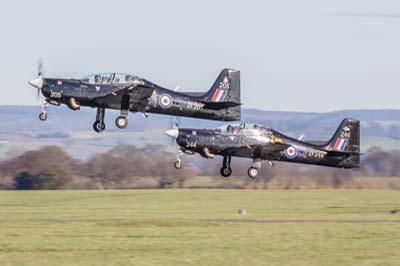 |
All Tucano T.1s were assigned to 1 FTS at RAF Linton-on-Ouse and initially flown by; 72 (Reserve) Squadron, 207 (Reserve) Squadron and 76 Squadron (Tucano Air Navigation Squadron). 76(R) were deactivated in May 2011 and 207(R) were deactivated in January 2012 due to the reduced requirements for student pilots. |
Some scenarios such as target runs are added to their low flying navigation sorties. "We will nominate a target and teach them how to find it" says Flt Lt Trueman. It teaches the student to apply the techniques behind reaching the target at a set time. The instructor will designate a bridge or an isolated building as the target which will be difficult to see. Five or six miles short of the target an initial point (IP) is chosen which is very easy to see and provides tactically the best direction from which to attack the target. The student will fly to the IP and from that point make their attack run to the target. Using their stopwatch and flying at a precise speed and heading they should arrive over the target at the set time. "There are parallels with what we teach here and what they do on the front line although then it will be completely computerised", says Flt Lt Trueman.
Step by step the students are pushed further he says; "We may say we have been advised that there is a surface to air missile site for example at the next turning-point, so they will have to come up with a plan to avoid that point but get back on-route by the next way-point." In deviating from their planned route they will be off their time-line and so will be early or late for their target, which they should hit at the planned time plus or minus five seconds. The student calculates how early or late they will be and re-plan the route to make up or lose time using navigational techniques alone and not by adjusting the speed of the aircraft.
Students after the 60 hour mark of the course will fly low-level navigational sorties to other airfields across the country. Up until now they have only operated from their home base which becomes very familiar to them. Like all other exercises students first fly with an instructor first before flying solo. Later students will individually plan their solo flight to a designated airfield. Utilising multiple aircraft students coordinate their flights, on route they will call over the radio if they have to adjust their flight plan due to poor weather or reattacking a missed target for example to maintain time separations as they are likely to be using common turning points such as lakes or railways or flying down flowed (one-way) valleys.
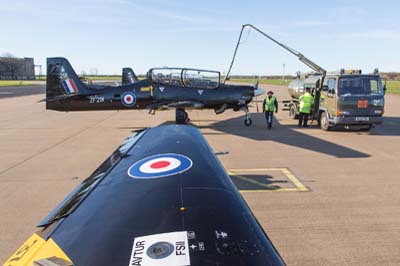 |
On the line refuelling the Tucano T.1s.
Following design modifications there is really only 50% commonality with the EMB-312, the principal differences being are; Garrett TPE331-10 engine with a four-bladed Hartzell propeller, strengthened airframe for an improved fatigue life, a cockpit layout similar to the Hawk T.1, a revised oxygen system, a flight data recorder, ventral airbrake and restyled wingtips. Two Martin-Baker MB 8LC ejection seats are used and the canopy was modified to meet the RAF's bird strike requirements.
We have to teach them seat pin discipline from the start. You have to make the seat live by taking the pin out which had stopped the ejection seat handle from being pulled. (You need 70 knots before you can safely eject on the ground). |
Flying in formation
Basic formation flying is introduced after the 45 hour mark, up until now they have been converting their skills learned on the Tutor to the Tucano using similar techniques flying perhaps just ten feet (3m) apart. Their lead aircraft will fly straight and level and the student 'on-tow' will be guided towards it by his instructor in the back-seat who will point out reference points on the lead aircraft which they use to line up with. "At the start this requires a lot of concentration but like all things with experience it becomes second nature, which is good because later on the students will have other things to contend with such as navigation", says Flt Lt Trueman. Formation flying starts with three flights with an instructor followed by a solo flight where the lead aircraft is flown by an experienced instructor. With a student on each wing the formation will fly straight and level with turns progressing to break and joins.
By combining close formation flying with navigation the students now have to get used to checking their instruments quickly while maintaining their position. The instructor in the back will be aware that the student in the front seat is looking down at his instruments, "If I see we are drifting too close to the leader I may need to take control", spoke Flt Lt Trueman, he went on to say, "You have to let them make the mistakes but intervene before it becomes dangerous, at that point you take control. The realisation why I took control can be startling but this gives them a very powerful lesson which they will remember".
More instrument flying sorties are flown before they come back to formation flying but combining it with navigation and down to low-level. As a prelude to their air combat training later at RAF Valley, students are introduced to the fighting wing formation and they will fly in formation but further apart. This tactic allows the leader the freedom to manoeuvre positively to avoid birds or obstacles for example without the risk of hitting his wingman. Follow-the-leader (tail chasing) exercises are flown so that the student can appreciate 'lead and lag' flying techniques, the leader will fly a series of aerobatic manoeuvres and the student wingman will be managing his energy by either pointing his nose ahead of the lead to close in or pointing it away to increase the distance between the two aircraft and so maintain the right position relative to the leader. These tail chasing exercises are normally flown in three ship formations which is more efficient and usually flown above 5,000 feet (1,524m) AGL they lay the foundation for air combat training taught later on the Hawk.
Flying at night
Night flying starts at flight 51 and totals five hours and including two hours solo. The night flying commences when the students are competent to fly using just only their instruments. Flt Lt Trueman spoke about the challenges faced by students flying at night, "When flown on moonlit evenings they are a blend of visual flying and instrument flying, in that you can see some things on the ground but will not see all the visual cues you can see in the daytime. In sparsely populated areas there will only be a few pin pricks of light on the ground which could look like stars confusing the pilot as to which way is up and so they need to rely more on their instruments".
Getting their Pilot's Wings
On completing the course successfully and graduating the students receive their 'wings' with a ceremony in front of their family and colleagues followed by a flying display. Flt Lt Trueman sums up his feelings at the end of the course, "I get a lot of satisfaction in helping all the students. They have brilliant minds and can have naturally a very good pair of hands and the only thing they lack is experience." However despite working very hard nearly all students need extra flying hours and tuition to get through a particular section of the syllabus to make the grade. "When I see them getting their pilot's wings and moving on to the Hawk that is when it all becomes worth it as an instructor", says a proud Flt Lt Trueman. |
Left to right: As some sorties were planned for an early morning departure a weather briefing was conducted specially for them, later planned sorties would have their own briefing. Apart from all aspects of flight affecting weather and the availability of diversion airfields, the duty officer will ask the assembled pilots random flight safety procedural questions. Today's question was about the EDSL (emergency shut down lever) situated behind the seat to the left and what should a pilot do if he operated it during flight in error which if on finals could have serious consequences if not dealt with correctly and promptly by the pilot.
Flt Lt Trueman has four years of experience at RAF Linton as an instructor pilot. Each student is allocated a primary and secondary instructor which they usually fly with throughout the course. He says, "There are advantages in [a student] having continuity with a small number of instructors, they can build up a rapport with your instructor due to familiarity, he will know their strengths and limitations so they get a more tailored learning experience".
Mission Planning using TucAMPA software.
Flt Lt Charlie Thompson QFI and the days duty authoriser is responsible for managing the flying program. This involves making sure it is acceptable by consulting the engineers over the availability and checking the fit of aircraft. Following their pre-flight briefing pilots will then discuss with him their sortie, the expected weather, diversionary airfields and the fuel they expect to have. Once satisfied the duty authoriser will ask the pilot to sign out the aircraft and walk to the flight line. Flt Lt Thompson says; "This job is mostly routine but there are challenges if we don't have enough aircraft to fulfil the program especially if problems occur during the day. Some pilots will have priorities, the weather may close in and so it can be quite busy at times". |
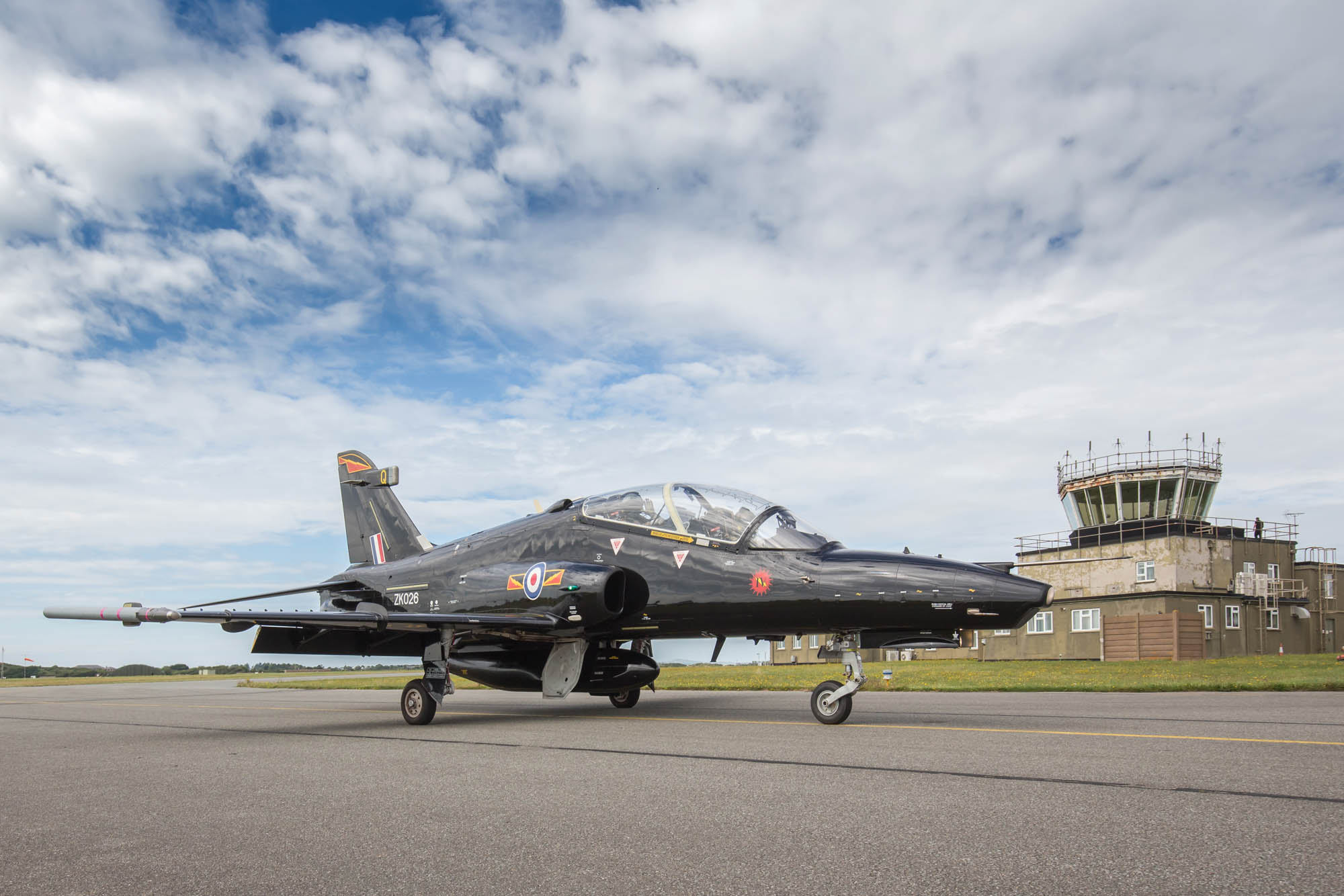 |
| The BAE Systems Hawk T.2, which arrived at RAF Valley in 2011, is the latest version of the Hawk aircraft which first flew at RAF Valley in the mid-1970s up until May 2016. |
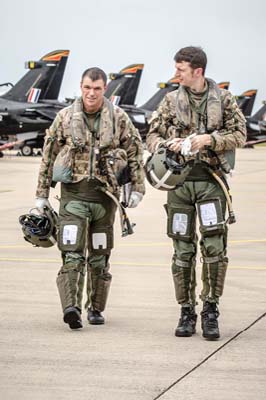 |
Two 4(R) Squadron instructor pilots walking towards the camera after completing their sortie. It looks natural does not look posed, we have positioned to get aircraft in the background. What makes the image is that one of the pilots is focused on the camera, while the other pilot is looking at him. Without the opportunity to ask the air crew to make specific poses it is important to look for natural expressions without them becoming self-conscious. |
Ascent Flight Training operations director Alasdair Shinner offers
an insight on how a rookie pilot becomes a top gun at RAF Valley.
Ascent Flight Training is tasked to provide the highest quality aircrew training for the Royal Air Force in the most cost effective way. Ascent is a joint venture between Lockheed Martin and Babcock International and was awarded the contract to be the Training Service Partner (TSP) to deliver the UK Military Flying Training System (UKMFTS) program, in partnership with the Ministry of Defence (MOD) out until 2033.
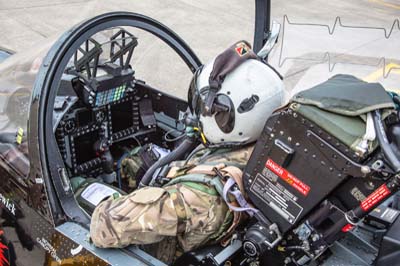 |
The computerised digital 'glass cockpit' of the Hawk T.2 taken with the permission of the pilot at the end of his mission. The same shot was taken of an empty cockpit but that does not have the same interest. |
A former RAF fighter pilot Al Shinner with 3,500 hours flying experience, which included operations in the Balkans, Falklands and the Gulf is fully equipped to handle the day to day challenges he faces at RAF Valley where student pilots learn to fly fast jet trainers. Students currently on graduation will transfer to a frontline squadron flying the Eurofighter Typhoon, supply to the older Panavia Tornado GR.4 squadrons has now ended. Students now starting their pilot training here could be lucky to be selected to go on to fly the world's most advanced combat aircraft, the Lockheed Martin F-35B Lightning II which will soon be in service with the RAF.
The premise of the UKMFTS programme was to draw out efficiencies in the training pipeline without compromising on training output standards. Pilot training is costly and methods are changing as more and more technology is being introduced in to the cockpits. The analogue cockpit instrument dials that have been around for nearly a century are being replaced by digital computer screens known as 'glass cockpits' in the latest aircraft. The UKMFTS program is procuring new aircraft with 'glass cockpits', featuring sophisticated digital displays that enable training aircraft to emulate the frontline aircraft. It is more cost effective to download training tools to training aircraft rather than use frontline aircraft for training purposes.
So how are Ascent able to reduce costs for the tax payer and yet meet the highest of standards of pilot training required by the MoD?
Pilot training on frontline aircraft is the most costly, by downloading this training to less expensive training aircraft it has reduced costs. Another and key area where cost saving objectives are achieved is through synthetic training. Students, their instructors and the frontline pilots all regularly spend time learning or refreshing their skills 'flying' multimillion pound networks of flight simulators ranging from desktop workstations to full-mission multichannel dome simulators, in which pilots can experience what they do in the air. "The only thing it can't simulate are pulling G force when you turn hard", says Al Shinner. Simulators eliminate fuel bills, aircraft running costs, flying accidents and the many ancillary services needed to keep aircraft flying safely.
The UKMFTS program is procuring new aircraft with 'glass cockpits', featuring sophisticated digital displays that enable training aircraft to emulate the frontline aircraft. It is more cost effective to download training tools to training aircraft rather than use frontline aircraft for training purposes. At RAF Valley students and their instructors fly the two-seat BAE Systems Hawk T.2 its 'glass cockpit' avionics suite provides a realistic advanced fast jet training platform. The aircraft is designed to replicate the experience of flying frontline aircraft so that the students' transition to Typhoon and F-35B Lightning II is smoother. The computerised emulation system enables complex scenarios such as air to air combat and ground attack to be simulated in the air. Virtual opponents and ground threats can be created to test the student. A Typhoon 'download' enables the student to 'see' its combat systems earlier in their flying training and at a tenth of the cost of flying the Typhoon.
UKMFTS is testament to the huge benefit and value derived from successfully run commercial contracts. Ascent works in partnership with the MOD and its purpose is to deliver world-class flying training to the UK Armed Forces.
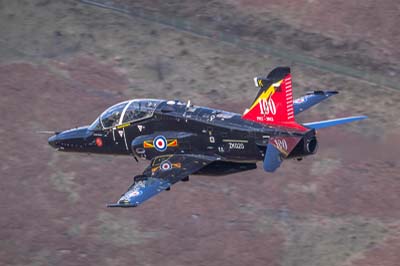 |
4(R) Squadron celebrated 100 years of flying operations in 2014 they painted the tail of ZK018 to commemorate this centenary. The Hawk T.2 has a data link which gives the pilot synthetic radar for intercept training. The aircraft also has a sensor simulation capability to allow realistic Electronic Warfare (EW) training against surface to air missile (SAM) systems. |
By awarding private finance initiative (PFI) contracts the MoD are bringing in investment technology and innovation, "It's more about value for money than cost saving", explained Al Shinner. "We do more flying training here than we once did now including elements of the training previously done on the Typhoon." Students following their synthetic training arrive at the Typhoon operational conversion unit (OCU) far better equipped to fly it than they ever did before.
At the heart of the UKMFTS program remains a military ethos in terms of training delivery; Ascent civilian and military instructors work alongside each other in seamless partnership to deliver optimized air- and ground-based training. Ascent are really working behind the scenes, pilots at RAF Valley fly as 4(Reserve) Squadron which has its own Wing Commander in charge. "We are in the background we just enable everything to happen, the students come to a military squadron to do military training", says Al Shinner. 4(R) Squadron is equipped with 28 Hawk T.2s and the 36 qualified flying instructors (QFIs) are still in the RAF, the eight ground instructors on the simulators are with Ascent but they still wear flying suits with squadron badges. They are all assessed to the same standards set by the RAF's Central Flying School. As use of the simulators forms a key part of the syllabus, it is important that ground and flying instruction is to the same standard.
The ground qualified instructors (QIs) in the first phase of the syllabus brief and train students using the simulators for basic flying, a close air support (CAS) phase is introduced later. The QIs also support the QFIs when the student starts to actually fly the Hawk. The QFIs do most of the later phases of flying as they will have most recently flown in the front line and have more up to date operational experience.
Each course comprises between four to six students, starting every six to eight weeks they will last a year. During the course the student should fly around 100 hours.
4(R) Squadron is divided in to three flights; 'A' Flight is where new students learn basic flying on the Hawk T.2, 'B' Flight is for tactical weapons training and 'C' flight is for instructor training and standardisation. On 'A' flight students will learn general handling, taking off and landing as well as instrument flying. Much of their navigation skills have been learned already on the Tucano, so they are really now being taught to manage the Hawk's systems in both the low-level environment and flying at night. Later the students will learn to attack ground targets on ranges and basic fighter manoeuvres in one versus one scenarios, before passing on to 'B' Flight.
In 'B' Flight the student progresses to acquire basic radar skills covering intercepts right up to using AMRAAM (Advanced Medium-Range Air-to-Air Missile) tactics using a data link which gives the pilot synthetic radar for intercept training. Air combat tactics training will now be with two versus one scenarios. Air to ground training now includes simulating Paveway IV drops from medium level and strafing at low-level. Advanced radar training follows with two aircraft working beyond visual range. Simulator work at this time includes CAS which is difficult to fly due to the weather and limited availability of JTACs (joint terminal attack controllers). Towards the end of the course students learn how to avoid surface to air missiles and time sensitive targeting, there is also an increased level of night flying. When operational, pilots will have 50% of their flying time at night and the students need to experience fighting at night before they go to their first front line squadron. The Hawk T.2 has the systems for tactical night flying and is actually NVG (night vision goggles) compatible although flying with NVGs is not currently in the course.
New aircraft
Following completion of the course graduates will transfer to 29(R) Squadron at RAF Coningsby. 29(R) is the OCU for the Typhoon. Up until 2016 students had been assessed for single seat or two seat aircraft, but with the out of service date for the two-seat Tornado of 2018 the final OCU course at RAF Lossiemouth was completed in November 2016 and the 15(R) Squadron (Tornado OCU) disbanded on March 31, 2017.
Students completing the course in the near future will be jointly assessed for Typhoon or the new F-35B Lighting IIs which should be based in the UK from mid-2018. The F-35B should be fully operational from 2020 operating from RAF Marham and from two new Royal Navy aircraft carriers, HMS Queen Elizabeth which was christened July 4, 2014 and HMS Prince of Wales. These new Queen Elizabeth Class Carriers are designed specifically for the F-35B, they include a ski jump ramp for short take-offs in place of the traditional catapult launch. The F-35B also has the ability to operate from land bases and remote locations, providing versatility that will revolutionise the UK's expeditionary combat power.
Fast Jet training at RAF Valley is one element of the vast UKMFTS programme delivered by the MOD and Ascent, which is set to include Fixed Wing, Rotary Wing and Rear Crew Training, with all elements of the world-class training program due to be fully operational by 2019.
The MOD has signed a contract as part of the UKMFTS with Affinity who will provide the training aircraft with support and maintenance. Affinity is a joint venture between Kellogg Brown and Root Ltd and Elbit Systems UK. In November 2016 the first two Grob G 120TP were delivered to Affinity at RAF Cranwell. Known as the Prefect T.1 with the RAF by 2018 they will replace the Tutor as the RAFs Elementary Training aircraft, providing each student with 40 hours of conventional flying from RAF Barkston Heath and RAF Cranwell. The Prefect has a fully digital cockpit, retractable undercarriage and a turbo prop engine providing a modern transition to the Beechcraft T-6C Texan II which is on order to replace the aging Shorts Tucano T.1 which will operate from RAF Valley from June 2018 with Ascent with the first student course scheduled for January 2019. "There is a massive interest in what we are now providing from air forces right across the world..everyone has come here to see what we are doing", says Al Shinner. |
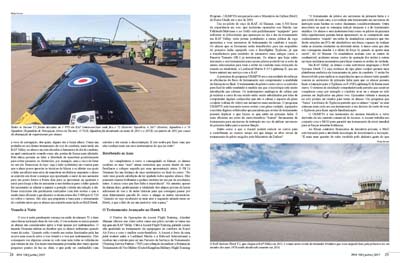 |
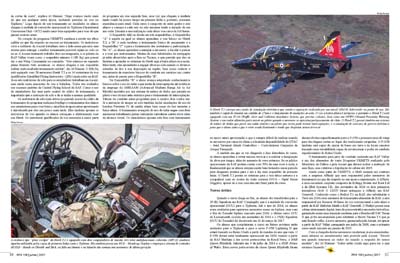 |
| Left to right: Tucano T.1s (ZF243 and ZF144). |
|
Tucano T.1 (ZF489). Shortly after vacating the runway after flight they will stop and do some landing checks to make sure the aircraft is safe before it taxis on to the flight line. The first thing pilots do is turn the command ejection system off, which enables the rear seat to eject the front seat, both pilots then make their own seats safe. They will turn off the strobes and carry out various housekeeping procedures such as switching off the navigational kit and returning flaps to the mid position. |
| Left to right: Tucano T.1s (ZF407 and ZF291). |
| Left to right: Tucano T.1s (ZF378 and ZF489). |
| Tucano T.1 (ZF244), pre-flight checks before early morning flight. |
| Left to right: Tucano T.1s (ZF205 and ZF244). |
| Left to right: Tucano T.1 (ZF287) and 'stepping' to the aircraft. |
| Tucano T.1 (ZF291) returns to the flight line. |
| Left to right: Tucano T.1 (ZF287 and ZF374). |
| Left to right: Tucano T.1 (ZF374, ZF172 and ZF485). |
| Left to right: Tucano T.1 (ZF485 and ZF205). |
| Left to right: Flt Lt Trueman at the controls of a Tucano (ZF205). |
| Left to right: Tucano T.1 (ZF205). |
| Tucano T.1 (ZF287) final checks |
| Left to right: Tucano T.1 (ZF343, ZF239 and ZF205 with ZF244). |
| Left to right: Tucano T.1 (ZF343, ZF239 and ZF287). |
| Tucano T.1 (ZF239) shutdown. |

